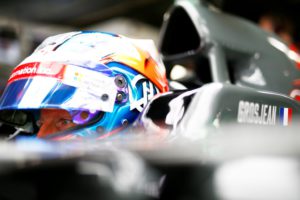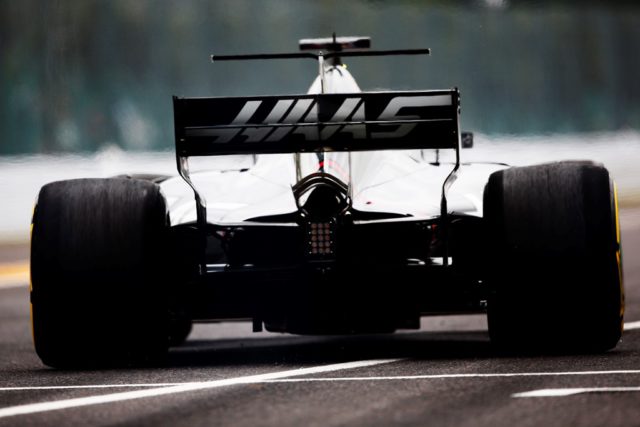Romain Grosjean took points in two of the last three races in Formula 1 and now he is ready for the next challenge – the United States Grand prix.
The Far East swing involved plenty of highs and lows for Haas F1 Team. You had to overcome two crashes – one in Malaysia and another in Japan – yet you came away with points in two of the three races to help the team regain seventh in the constructors’ standings. Talk about how the team handled that adversity and then delivered when it was time to race.
“I guess it was a pretty good three-race swing in Asia. We had ups and downs but, generally, we learned a lot, especially after Sepang – getting it right for Suzuka. A double-points finish for the team was pretty big. Singapore, we saved what we could. We didn’t have huge performance, but we had a pretty good race. In Japan we found the sweet spot on the tires, so that was good.”
Japan was obviously the high point of the Far East swing with a double-points finish. How important was that result as the team heads into its home race – the United States Grand Prix?
“It’s important for the constructors’ championship because there’s a tight fight there. Austin is always a special one for us. It shows that we’re growing up. We’re going there for the second time in our history, and off the back of eighth- and ninth-place finishes, which is pretty good.”
Japan’s Suzuka Circuit has been a strong venue for Haas F1 Team. It was the first track where Haas F1 Team got both its cars into Q3, and it was the scene of the team’s second double-points finish. How does that track seemingly play to Haas F1 Team’s strengths?
“It’s a combination of things. I think it’s very much a driver’s track, where you can try to make the difference. Last year we found a good setup and we tried to use it again this year, but I don’t think it’s truly related to the track. I think we’ve been performing well in other places this year. Generally, I’d say that higher-speed circuits are better for us than lower-speed circuits.”
How do you attempt to transfer a strong finish in Japan to another strong finish at COTA?
“The truth of one race is not the truth of the next one. It was a good result for us, for Gene (Haas) – who was there – it was a very proud moment. I’m proud of all of us, but for Austin we need to focus on what we can do. We need the right setup, get the right tools and just work as we do, normally. It was pretty good in Japan, but it doesn’t necessarily mean that it’ll be the same in Austin. We need to work hard to make it good.”
In joining Haas F1 Team, you took a leap of faith in the vision Gene Haas had for an American Formula One team. What has it been like to be a part of this endeavour and what makes Haas F1 Team different from other Formula One teams?
“I think every team is different, but we’ve got Gene who absolutely loves racing. He’s an amazing team owner. He’s very much involved. He loves it. He’s always trying to understand and get the best from everyone. That’s great to see. I’d say the team runs as every Formula One team does, but we know that we’ve got Gene behind us. He likes us to give our best and that makes it a great place to be and to work.”
Haas F1 Team accomplished a lot in its debut season. Can you talk about the team’s growth this year and, specifically, how it has outperformed compared to last year?
“You never realize how much you can grow until you’ve seen what you’re doing. From our start, the team is now much more experienced and much stronger. There are a lot of things we can improve to get better and better. From day one though, the team is much stronger in every area. There are no places where we are weaker. We’ve got better strategy, better engineering, better mechanics – everything is more organized around the racetrack. It’s just the way it is when you start, but then you grow up. We know where we can still improve the team and we know we’ve got room for that, so that’s really good for the future. When you think that most of the teams are at their maximum, or are running at their maximum, we know how much we can do and still improve. It shows that there could be a really bright future.”
You’re racing for an American team in the United States Grand Prix. Because of that, does walking into the paddock at COTA and driving out of the garage and onto the track take on greater significance or give you an added sense of pride?
“Yeah, it’s a great one to go to. I’ve always loved Austin, but since I’ve been a Haas driver, I love it even more. I haven’t had the chance to have a national grand prix – that’ll come next year in France – but Austin is the one where I get to represent America.”
Formula One returned to the United States after a four-year absence when it raced at COTA in 2012. You participated in that race. What was the industry’s reaction to Formula One’s return to America?
“It was wonderful. We had a lot of fans and people really came to see the race. It’s a great venue and one of the best new tracks we’ve had in quite a while. The track was great, the city is nice, and it was a very nice experience.”
 When you first competed at COTA, what did you think of the venue?
When you first competed at COTA, what did you think of the venue?
“It was very nice and very well organized. The city is great. There are a lot of bars and concerts going on in the city, and people came from all over the country to see the race. It was amazing.”
You equalled your career-best Formula One finish (second) at COTA in 2013. Talk about that race.
“It was a wonderful race. I started third on the grid and proceeded to make a great start. We didn’t think we’d keep Red Bull Racing behind, but we managed. We had a good car and, ultimately, I had a really good race.”
COTA’s first corner is at the top of a hill – a blind and tight left-hander that sends drivers into a section modelled after Silverstone’s Maggotts-Becketts-Chapel complex. How do you approach that corner knowing there’s a moment when you don’t know what’s on the other side?
“You know that nobody’s coming the wrong way, so that really helps when you come to the corner. It’s really about focusing on the right thing at the right time. First, the braking point, then the turning point, and then the apex and exit. Yes, it’s a blind corner, but once you’ve got in the rhythm you just take it all step-by-step and there are no surprises.”
COTA has been described as having the most overtaking opportunities of any track on the Formula One calendar. Is this accurate and, if so, what makes COTA better for overtaking than other venues?
“It’s not that simple to overtake at COTA. You’ve got a huge straight line on the back straight, which helps, of course, with the DRS. The braking into turn one is very wide and you can have some chances there. But, on the other hand, it’s very hard to follow in sector one, and into that very long right-hand side corner before the last two corners.”
What is your favourite part of COTA?
“All of sector one.”
Describe a lap around COTA.
“First you brake on the very wide track uphill into turn one. You then have tricky traction going downhill through sector one. It’s very high speed – very similar to Silverstone. Here you try to carry some good speed. Then you go to the hairpin before the back straight, again you want good traction here. There’s very big braking at the end. Then there’s a very tight section with a double right corner. After that it’s a long left hairpin, with tricky braking, then a full right-hand side corner, almost flat out in qualifying. Then it’s the two mid-speed final turns, which are pretty interesting, going down into the first one, and the second one going up again before you finish the lap.”
Austin has become a destination venue for the Formula One industry, much like Singapore and Monaco. Why does the city resonate so well with those in Formula One?
“I think because it’s the United States Grand Prix. Austin is a great city and it gets a lot of fans visiting, too. There’s also a great atmosphere around the track.”
How much of Austin have you been able to explore, and is there an area of the city you like the most?
“I’ve seen quite a bit of Austin. The nightlife is amazing, too. During the day there are some nice shopping centres. It’s a great place.”
Wakeboard ???#r8g #fun #lake pic.twitter.com/f3QXmRkFyW
— Romain Grosjean (@RGrosjean) October 13, 2017
































